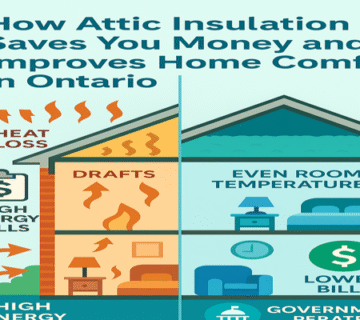If you’re a homeowner in Ontario — Toronto, Mississauga, Markham, Richmond Hill, or anywhere in the GTA — you already know how extreme our climate can be. Icy winters, humid summers, and rising energy bills make maintaining a comfortable home a challenge. One of the most common but often overlooked issues? Poor attic insulation.
Your attic acts as the thermal “cap” of your home. If it’s under-insulated, your furnace and air conditioner are working overtime, your energy bills are climbing, and your comfort is suffering. The good news is that recognizing the signs early — and fixing them — can transform your home into a more energy-efficient, comfortable, and affordable place to live.
In this guide, we’ll cover the top 10 warning signs that your attic insulation needs attention and exactly how to fix them. Along the way, we’ll also highlight:
- How much attic insulation costs in Ontario
- Which insulation types work best in Toronto, Mississauga, Markham, and Richmond Hill
- The latest attic insulation rebate Ontario homeowners can claim in 2025
- Tips for choosing the right insulation contractors Ontario families can trust
Let’s dive in.
- Sky-High Energy Bills
If your heating or cooling bills seem higher than your neighbours’ — or if you’ve noticed a big increase compared to last year — poor attic insulation may be the culprit.
Why It Happens:
Heat rises. In winter, warm air escapes through an under-insulated attic, forcing your furnace to run longer. In summer, hot attic air seeps down into your living space, overworking your AC.
How to Fix It:
- Schedule an energy audit Ontario homeowners can trust to measure heat loss.
- Upgrade to blown-in cellulose or spray foam insulation for maximum coverage.
- Apply for an attic insulation rebate Ontario programs offer to reduce costs.
- Uneven Temperatures Between Floors
Is your upstairs freezing in the winter but sweltering in the summer? Uneven temperatures are a classic sign of insufficient insulation.
Why It Happens:
Without adequate attic insulation, the upper floor becomes a heat “exchange zone” — leaking heat in winter and absorbing it in summer.
How to Fix It:
- Add insulation to achieve at least R-60 in Ontario attics.
- Seal air leaks around ducts, plumbing, and recessed lighting.
- Consider spray foam for homes in Markham or Richmond Hill prone to ice damming.
- Drafts in Upstairs Rooms
Cold air sneaking into bedrooms and hallways upstairs isn’t always due to windows or doors — often, it’s your attic.
Why It Happens:
Air leakage through uninsulated gaps in the attic allows cold outdoor air to enter living spaces.
How to Fix It:
- Air seal attic penetrations with caulking or spray foam.
- Upgrade attic insulation in Toronto and Mississauga homes that often lack proper air barriers.
- Ice Dams on Your Roof in Winter
If you see icicles hanging off your eaves or ridges of ice along your roof, your attic insulation is failing.
Why It Happens:
Heat escaping from your home melts roof snow, which refreezes at the edges — creating ice dams that damage shingles and gutters.
How to Fix It:
- Increase attic insulation thickness.
- Improve ventilation with soffit and ridge vents.
- Hire experienced insulation contractors Ontario who can combine air sealing with insulation.
- Hot and Stuffy Second Floor in Summer
In July and August, many GTA homes with poor insulation have unbearable upstairs bedrooms.
Why It Happens:
Without insulation, your attic turns into a 60°C oven that radiates heat downward.
How to Fix It:
- Add reflective radiant barriers plus blown-in insulation.
- Ensure proper attic ventilation to exhaust trapped hot air.
- Visible Insulation Gaps in the Attic
Take a quick peek into your attic. If you see thin layers, bare patches, or compressed material, your home is under-insulated.
Ontario Insulation Standards:
- Modern building codes recommend R-60 or about 16–20 inches of insulation in Ontario attics.
- Many older homes in Toronto, Mississauga, and Richmond Hill only have 4–6 inches.
How to Fix It:
- Top up existing insulation with blown-in cellulose or fiberglass.
- Remove damaged insulation before adding new material.
- Pest or Rodent Problems in the Attic
Mice, squirrels, and insects love nesting in old insulation. Beyond being a nuisance, this weakens insulation performance.
How to Fix It:
- Hire professionals to remove soiled insulation.
- Install new pest-resistant insulation (cellulose is treated with borates for pest resistance).
- Frequent Furnace or AC Cycling
Does your HVAC system constantly turn on and off? That’s a red flag.
Why It Happens:
Rapid temperature loss forces your furnace or AC to run more often. This increases energy bills and shortens equipment life.
How to Fix It:
- Upgrade attic insulation to reduce load on HVAC.
- Combine with air sealing to stop leaks.
- Moisture, Mold, or Musty Smells in the Attic
Poor attic insulation and ventilation trap moisture, leading to mold growth.
Why It Happens:
Warm indoor air meets cold attic air, creating condensation on rafters and insulation.
How to Fix It:
- Install proper insulation with vapor barriers.
- Add ventilation to regulate attic humidity.
- Replace mold-contaminated insulation immediately.
- Insulation Older Than 15–20 Years
If your attic insulation hasn’t been touched in decades, it’s probably not doing its job.
Why It Matters:
Old fiberglass or cellulose settles over time, reducing R-value. Plus, building codes in Ontario have evolved — what was acceptable in 1990 no longer meets today’s standards.
How to Fix It:
- Book an inspection with insulation contractors Ontario homeowner’s trust.
- Plan an attic insulation upgrade Toronto and GTA homes often need to meet current energy-efficiency requirements.





No comment